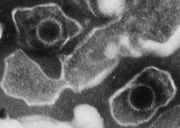Epstein Barr virus
Classification
Higher order taxa
Group: Group I (dsDNA) Family: Herpesviridae
Subfamily: Gammaherpesvirinae
Genus: Lymphocryptovirus
Species: Human herpesvirus 4 (HHV-4)
Species
Lymphocryptovirus Human herpesvirus 4
Description and significance
The Epstein-Barr virus is a member of the herpesvirus family. EBV is one of the most common human viruses that occurs worldwide. At one time in their lives most people become infected with the EBV. In the United States, between the ages of 35 and 40 years 95 percent of adults have been infected by the virus. When adolescents and young adults are infected with EBV, infectious mononucleosis is cause 35-50 percent of the time.
Genome structure
The B95-5 strain of the Epstein-Barr virus is comprised of 172,282 base pairs. Through mapping, likely regions of protein-coding have been found to encode for a ribonucleotide reductase, a DNA polymerase and two surface glycoproteins
Cell structure and metabolism
The gp42 glycoprotein of the EBV binds to MHC class II molecules. This binding is important in the process of infecting the B lymphocytes. Gp42 glycoprotein belongs to the C-type lectin superfamily and has a crystal structure bound to the human MHC class II molecule HLA-DR1. The EBV gp42 binds to HLA-DR1 using a distinct surface site, which forms a hydrophobic groove and the canonical ligan binding site. This hydrophobic groove can avoid coupling mechanisms for MHC recognition and memabrane fusion, by interacting with other ligands necessary for EBV virus entry.
Ecology
The EBV has a ubiquitous and uniform epidemiological distribution. The strategy of the virus is to guarantee transmission through persistence and continuous replication. These two characteristics of the virus occur in the B lymphocytes where latency takes place and in the epithelial cells where replication occurs, EBV-associated malignacies could potentially take place in these cellular compartments.
Pathology
The Epstein-Barr virus can cause infectious mononucleosis. Infectious mononucleosis can be contracted when a person is in pre to early adolescence. The transmission of mononuleosis can occur through the transfer of saliva and also through contact with the virus when it is airborne. The Epstein-Barr Virus mainly replicates in the beta-lymphocytes and also can replicate in the epithelial cells of the pharynx and parotodid duct. Common symptoms are fever, pharyngitis, adenopathy, malaise, and an atypical lymphocytosis.
Application to Biotechnology
In a EBV-negative Burkitt's lympoma-derive cell line, the cellular antiapoptotic bf1-1 gene allows protection from apoptosis in conditions where there is a deficit in growth factor. The latent membrane protein 1 of EBV and CD40 its functional homologue can drive bf1-1. This can happen through NF-B-dependent enhancer elements that are found in the bf1-1 promoter. The EBV nuclear antigen 2 also upregulates bf1-1, which requires CBF1 for its trans-activation. CBF1 is a nuclear component for the Notch signaling pathway. The process of trans-activation depends on the EBNA2-CBF1 interaction, which is regulated by EBV gene products. BF1-1 expression is caused and sustained at high levels by EBV growth program. Through these interactions the understanding of EBV persistence in malignant disease and B-cell development becomes pertinant.
References
http://www.cdc.gov/ncidod/diseases/ebv.htm National Center For Infectious Diseases "Epstein-Bard Virus and Infectious Mononucleosis."
Andersson JP. Clinical aspects of Epstein-Barr virus infection. Scand J Infect Dis Suppl 1991;80:94-104
Baer R, Bankier AT, Biggin MD, Deininger PL, Farrell PJ, Gibson TJ, Hatfull G, Hudson GS, Satchwell SC, Séguin C, et al. DNA sequence and expression of the B95-8 Epstein-Barr virus genome. Nature. 310(5974):207–211. [PubMed]
Bailey RE. Diagnosis and treatment of infectious mononucleosis. Am Fam Physician 1994;49:879-88.
http://www.ncbi.nlm.nih.gov/pubmed/8713470 Schmidt CW, Misko IS. "The ecology and pathology of Epstein-Barr virus." Immunol Cell Biol. 1995 Dec;73(6):489-504
http://linkinghub.elsevier.com/retrieve/pii/S1097276502004653 "Structure of the Epstein-Barr Virus gp42 Protein Bound to the MHC Class II Receptor HLA-DR1." Molecular Cell , Volume 9 , Issue 2 , Pages 375 - 385 M . Mullen , K . Haan , R . Longnecker , T . Jardetzky
B. D'Souza, M. Rowe, and D. Walls, J. Virol. 74:6652-6658, 2000
B. N. D'Souza, L. C. Edelstein, P. M. Pegman, S. M. Smith, S. T. Loughran, A. Clarke, A. Mehl, M. Rowe, C. Gélinas, and D. Walls, J. Virol. 78:1800-1816, 2004
http://jvi.asm.org/cgi/content/abstract/80/16/8133 "Epstein-Barr Virus Nuclear Antigen 2 trans-Activates the Cellular Antiapoptotic bfl-1 Gene by a CBF1/RBPJ-Dependent Pathway" Article Journal of Virology, August 2006, p. 8133-8144, Vol. 80, No. 16
